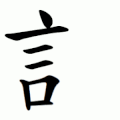Hello, you have come here looking for the meaning of the word
訁. In DICTIOUS you will not only get to know all the dictionary meanings for the word
訁, but we will also tell you about its etymology, its characteristics and you will know how to say
訁 in singular and plural. Everything you need to know about the word
訁 you have here. The definition of the word
訁 will help you to be more precise and correct when speaking or writing your texts. Knowing the definition of
訁, as well as those of other words, enriches your vocabulary and provides you with more and better linguistic resources.
Translingual
| Stroke order
|

|
Note that in Japanese and Korean, the 亠 component on top of the character is written 二, similar to the form found in the Kangxi dictionary.
Han character
訁 (Kangxi radical 149, 言+0, 7 strokes, cangjie input 難難卜一一 (XXYMM) or 卜一一口 (YMMR), composition ⿳丶三口(GHTV) or ⿱亖口(JK))
- Kangxi radical #149, 言.
References
- Kangxi Dictionary: not present, would follow page 1146, character 1
- Hanyu Da Zidian (first edition): not present, would follow volume 6, page 3936, character 1
- Unihan data for U+8A01
Chinese
Pronunciation
Definitions
訁
- Left radical form of Kangxi radical #149 言 (yán, to speak).
Usage notes
Usually referred to as 言字旁 (yánzìpáng), but 言字旁 may also be found in other positions, e.g. bottom component of 讋/詟 (zhé), which is left unsimplified.
Japanese
Kanji
訁
(Hyōgai kanji)
- Component form of 言.
Usage notes
- Generally referred to as ごんべん (gonben).
Vietnamese
Han character
訁: Hán Nôm readings: ngôn
- This term needs a translation to English. Please help out and add a translation, then remove the text
{{rfdef}}.


